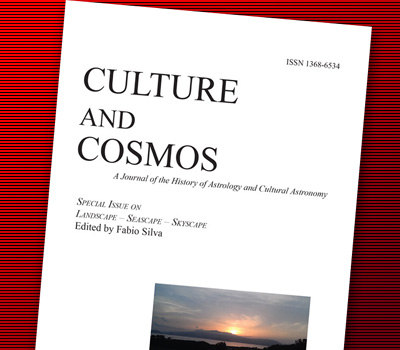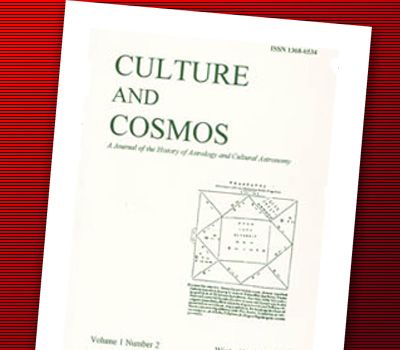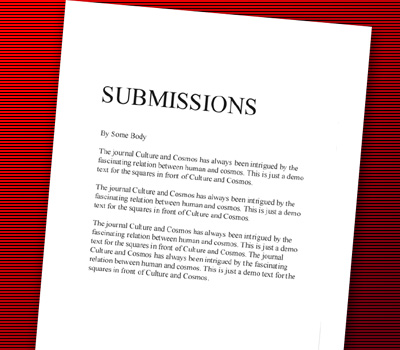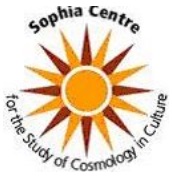We are currently seeking submissions for future volumes of Culture and Cosmos.
Volume 1, No. 2
Review: La cosmogonie égyptienne avant le Nouvel Empire, Susanne Bickel. Orbis Biblicus et Orientalis 134, Editions Universitaires Fribourg, Suisse, 1994. SF 98
Rosalind Park
How arresting it would be if some scholar were bold enough to suggest that the Heliopolis Creation story was the first treatise on Physical Chemistry! How tantalizing it would be to think that the myth was a description of how the fundamental elements and their characteristics evolved to make universal matter. Allowing that all carbon-based life would eventually perish, all life, once having come into Being could continue for ever. Translate the Egyptian word for ‘sunlight’ (the most essential component for the planet’s energy and for plant growth) into the modern idiom of ‘electromagnetic radiation...’, and the imagery, for us, becomes more awesome and powerful - exactly the attributes the ancients gave Sunlight. Now, allow the properties of 02 and H20 to be represented by Shu and Tefnut respectively...
Whether it is correct or not, this alien view of Egyptian cosmogony throws up the problem of nuances lost in triple language translations over 4000 years. Spell 77 of the Coffin Texts: ‘I am this soul of Shu which is in the nbi (difficult to translate from the hieroglyphs - seems to be a technical word describing volume) of the fiery blast which Atum kindled with his own hand’ (? = spontaneous combustion).
There are no hermetical revelations (or references to theoretical physics!) in Susanne Bickel’s book. In the absence of any other controversial source there is perhaps no reason why there should be. The Coffin Texts, written mainly on Middle Kingdom coffins, are the prime reference for genesis in Egypt and the main core of Egyptian cosmogony. In her re-worked 1993 Ph.D thesis, Bickel reinforces them with other Middle Kingdom writings as well as the few relevant Old Kingdom Pyramid Texts. Of minor note, the French translation sometimes reads better than the familiar English translations of Coffin Texts especially relating to Shu: ‘I am Life’ rather than Faulkner’s ‘I am one who lives’; and sn: read as ‘breathes’ instead of ‘kisses’ where ‘Nu said to Atum: breathe your daughter Maat, put her at your nose, that your heart may live’ CT 80. The quaint line of Bickel’s hymn to Re on the stele of Antef qbb fndw w3.f r nsn she translates ‘noses freeze when he becomes angry’ and might suggest a colloquialism like ‘scare the pants off... ‘!
This book, strictly for the academic market, is a compendious work well laid out with clearly printed source of quotations arranged by subject matter. The author’s eye focuses closely on each stage of the creative process, as life - i.e. differentiation - emerges from the amorphous void, pre-existent and yet with two watery components nnw and hhw and two dark and obscure ones kkw and knmw . The emergent Atum first creates himself, by whatever means, and then a son and daughter to develop and maintain the newly summoned cosmos and its inhabitants. His son Shu is documented in CT spells 75-83, The ‘Book of Shu’, in which he and Atum jointly create 8 hhw spirits to aid them; but other spells promote either Ptah, Hapi or Heka to be the creator-son. The numbers 1,2,4 and 8 occur as Shu and Tefnut produce Geb and Nut who then bring the Ennead (8+1) into being, but Bickel doesn’t explore this. She contents herself with meticulously noting the different ways in which Atum drew his children out of his own substance, each having a slightly different idea behind it.
The author tabulates the common aspects of the four creator-sons, and notes Tefnut’s identity with Maat, the face of order that was created to combat the disorder of the Nun (Nww), i.e. chaos, without discussing it. She states that there is just one vague connection to water in the spells which might echo Shu’s connection to air. Bickel ignores the PT’s witness here: Atum created them both by watery-spittle in [600]; in [685] Tefnut and Shu both created the waters that exist through Atum, as well as providing the King’s food and drink [338, and v.v.339].
On the creation of mankind, the problem of evil - which man brought upon himself, and the end of the world, the ideas are noted to appear in different brief combinations rather than one exclusive connected narrative. It seemed more important for the Egyptians to keep their options open and look from different angles, even if they appeared contradictory. These protocols were not prominent in organised ritual or festival, but came to be used for the deceased’s benefit and in the hope that he would become as omnipotent as Atum and the creator-sons in the Beyond. Neither were there strong local traditions of their place of origin; it was somewhere ‘other’ until Heliopolis, powerful in its proximity to the Memphis court, gradually fixed them on its own territory. With the advent of the New Kingdom, Atum - or rather Atum / Re, was still the one creator who, after his vital moment of autogenesis, worked thereafter through his sons to keep life going. By this time, Bickel remarks, city gods, usually with a solar aspect, were increasing in evidence and also a division was appearing between creation-time and present time; there was no longer a continuity.
The dichotomy of endless time and the finer points regarding the words nhh and dt, usually translated as ‘Eternity’, are touched upon. Differential concepts of nhh and dt are somehow interrelated to the major principles of Life and Maat. Everlasting nhh belongs to the father of millions Shu and indicates masculine, active, and diurnal qualities and is ideally translated as ‘perpetuity’. The infinity of dt associated with Tefnut identifies the feminine, passive, and nocturnal qualities of eternity.
In other ancient cosmologies, the four elements were the basic components of creation. Our latter-day ‘cosmogony’ proposes that the elements other than hydrogen - the nitrogen in air, the oxygen in water etc., were forged in the nuclear furnaces deep inside stars. The first alchemists assumed the world to be one of mathematical order and rationality. The four creator-sons of Egyptian cosmogony were Shu, Hapi, Ptah, and Heka. The temptation to equate Shu to Air, Hapi to Water, the clay-modeller Ptah to Earth, and Heka/magic to Fire does not tempt Bickel even remotely. She quotes Hornung’s Conceptions of God in Ancient Egypt several times in footnotes, but ignores his remarks p 208-9, that Heka is a force. Hornung describes the lightning strike-power of Heka against Apopis as ‘the nuclear energy of early civilizations because of its dangerousness and its power to transform the world’. In Merikare’s Instructions, quoted by Bickel, the creator passes the gift of magic to men to defend them - it is man’s fault if it rebounds (very much the pre-Platonist view that the evils in human experience are the consequences of wrong free choices). By Ptolemaic times, it is attested that the magician works by Fire. In religious experience, the element Fire becomes the deep intuition in human beings whereby they can know what is incapable of being expressed in words.
The mathematical cosmology attributed to Plato is likely to have been refined, or even debased, by him from earlier held views in other lands. If one codifies the deities with numbers, one (Atum) becomes two (Shu and Tefnut); two become four (Nut and Geb), four becomes eight (the Ogdoad). This is the binary series which forms the basis for all of Egyptian arithmetic. The intelligentsia of Ancient Egypt must have comprised an equal distribution of thinkers, scribes and natural philosophers (scientists). As an adjunct or to counter-balance the literary records of creation myths, the latter would have been an intellectual force for recording, in the artwork of the age, the origins of their universe in terms of their own coded symbols and mathematical formulations. The scientific mind thinks and describes the world in terms of numbers and diagrams instead of double entendre words; on the other hand, the graphic artist does not have to rely on text to depict the Creation of the World.
‘In the beginning was the Word...’ There are no pictures but there are plenty of words in Dr. Bickel’s French-language text which reveals the bias of religious leadership with regard to the Creation story. Paradoxically, a number of key Alchemical words emerge from her text: the quintessence of Re, pelican, division, separation, and transformation. Perhaps these inclusions are unwitting but for me they are temptation to suppose that the science behind the cosmogony of ancient Egypt makes this tome far from complete.









